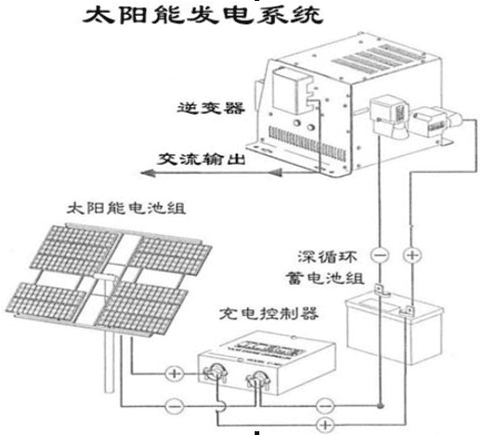
Solar Power Generation System
Introduction of solar power generation system
Solar power system (power plant) consists of solar battery, batteries, inverters and solar charge controller. 12V, 24V or 48V DC can be directly supplied. It can also offer 220V, 380V AC power. See the figure below.
A brief introduction of the functions of the various parts.
1. Solar panels The role of solar panels will directly convert solar radiation into direct current for the load in use or stored in a battery backup. Generally based on user needs, a certain number of solar panels will be connected to form a solar cell matrix, adding the appropriate support and connection box.
2. Charging control device Charge control device mainly consists of decicated processor CPU, electronic components, monitors, switching power transistor and other components. In the solar power generation system, the charging control device's basic function is to provide the best for the battery charge current and voltage, fast, stable, efficient battery charging and to reduce losses in the battery charging process and extend battery life. It also protects the battery from overcharging and overdischarging phenomenon. Various important data in the systems, such as charge current and voltage will be recorded and displayed at the same time.
3. Inverters The role of the inverter is to convert the low voltage DC provided by solar cells and batteries into 220V or 380V AC reverse to supply AC load.
4. Batteries Square matrix solar cell battery stores DC issued and DC will be used by the load. In the photovoltaic power generation system, the battery discharge is in floating state. Square matrix cell charges the battery during the day and square matrix electricity release electricity to the load from the battery in the evening. Therefore, the self -discharge of the required battery should be smaller and higher efficiency. Whereas we should consider the price and whether it is convenient and etc.
Significant features of solar system
1. Nearly 100% reliability for power supply can fully adapt to various weather conditions;
2. The automatic control equipment can be under minimal supervision by people;
3. Management and maintenance is simple and convenient, the operating cost is low too;
4. The life of main component service is up to 20 years;
5. One investment is in long-term benefit;
Design Principle
Solar power system design requires coordination between the user and the professional solar technology company. First of all, the user must provide the exact use requirement, including:
1. The power voltage, and power need to address;
2. Daily working time, protection of consecutive rainy days time'
3. Whether back up electric power supply;
4. The system coverage area and climate data;
5. The equipment name, user manual or technical parameters need to be supplied.
After the company received the user's usage requirements, it will conduct the initial configuration of the system and budget, more precise communication with the user on the process of design at any time and reasonable suggestions will be advised.
Due to the one-time high input costs for solar power supply, economic utility is the principle during design, minimize the investment cost and som of the key components need to be selected as high-quality products as possible to extend the working life of the whole system, improve system reliability and reduce failure rate.
Design factors of Solar power system should consider:
1. Where the solar system should be used? How is the situation of the solar radiation?
2. How much power does it load?
3. How much the load voltage does it load. Is it DC or AC?
4. How many work hours per day?
5. How many days should be needed to consecutive supple power If there is no sunlight in rainy days?
6. Load conditions, pure resistive, capaitive or inductive, and how much does the starting PM?
7. The number of system requirements.
8. On-site conditions and the environment of system installation.
9. The investment scale that the users are willing to commit.



